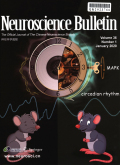- 钛学术文献服务平台 \
- 学术期刊 \
- 医药卫生期刊 \
- 神经病学与精神病学期刊 \
- 神经科学通报(英文版)期刊 \
Recanalization Treatment for Acute Stroke: Can We Skip the Bridge?
Recanalization Treatment for Acute Stroke: Can We Skip the Bridge?
基本信息来源于合作网站,原文需代理用户跳转至来源网站获取
摘要:
More than 2 million new ischemic stroke patients are diagnosed every year in China, with a prevalence of about 11 million.Stroke is the leading cause of death in the country [1, 2].The therapeutic effect on ischemic stroke in the ultra-early period depends on the timely restoration of the blood supply to rescue brain tissue.The current guidelines recommend that patients should be treated with intravenous thrombolysis within 4.5 h after symptom onset.Even for patients with large artery occlusion suitable for mechanical thrombectomy, intravenous thrombolysis has the advantages of a rapid start-up, increasing the chance of recanalization and improved microcirculatory function [3].However, thrombolysis therapy has limitations, including a higher risk of hemorrhage transformation and higher cost, as well as the possibility of occlusion in distal vessels if the clot breaks into pieces.Therefore, neurologists have been trying to determine whether intravenous thrombolysis can be skipped to perform mechanical thrombectomy directly.

推荐文章
Padlocks of Love on The Brooklyn Bridge
五金制品工业
五金制品
理论
原材料
表面修饰对镁合金WE42生物相容性的影响
合金
镁
生物相容性材料
材料试验
显微镜检查
电子
扫描
乳酸
脐静脉
内皮细胞
WE43镁合金铸件低压-熔模铸造
WE43镁合金
阻燃陶瓷型壳
低压熔模铸造
内容分析
关键词云
关键词热度
相关文献总数
(/次)
(/年)
文献信息
| 篇名 | Recanalization Treatment for Acute Stroke: Can We Skip the Bridge? | ||
| 来源期刊 | 神经科学通报(英文版) | 学科 | |
| 关键词 | |||
| 年,卷(期) | 2021,(4) | 所属期刊栏目 | Research Highlights |
| 研究方向 | 页码范围 | 585-587 | |
| 页数 | 3页 | 分类号 | |
| 字数 | 语种 | 英文 | |
| DOI | |||
五维指标
引文网络
引文网络
二级参考文献 (0)
共引文献 (0)
参考文献 (9)
节点文献
引证文献 (0)
同被引文献 (0)
二级引证文献 (0)
2017(3)
- 参考文献(3)
- 二级参考文献(0)
2018(2)
- 参考文献(2)
- 二级参考文献(0)
2019(3)
- 参考文献(3)
- 二级参考文献(0)
2020(1)
- 参考文献(1)
- 二级参考文献(0)
2021(0)
- 参考文献(0)
- 二级参考文献(0)
- 引证文献(0)
- 二级引证文献(0)
引文网络交叉学科
相关学者/机构
期刊影响力
神经科学通报(英文版)
主办单位:
中国科学院上海生命科学研究院
出版周期:
双月刊
ISSN:
1673-7067
CN:
31-1975/R
开本:
16开
出版地:
上海市岳阳路319号31B楼405室
邮发代号:
4-608
创刊时间:
1985
语种:
eng
出版文献量(篇)
2003
总下载数(次)
1
总被引数(次)
9688
期刊文献
相关文献
推荐文献
- 期刊分类
- 期刊(年)
- 期刊(期)
- 期刊推荐
神经科学通报(英文版)2022
神经科学通报(英文版)2021
神经科学通报(英文版)2020
神经科学通报(英文版)2019
神经科学通报(英文版)2018
神经科学通报(英文版)2017
神经科学通报(英文版)2016
神经科学通报(英文版)2015
神经科学通报(英文版)2014
神经科学通报(英文版)2013
神经科学通报(英文版)2012
神经科学通报(英文版)2011
神经科学通报(英文版)2010
神经科学通报(英文版)2009
神经科学通报(英文版)2008
神经科学通报(英文版)2007
神经科学通报(英文版)2006
神经科学通报(英文版)2005
神经科学通报(英文版)2004
神经科学通报(英文版)2003
神经科学通报(英文版)2002
神经科学通报(英文版)2001
神经科学通报(英文版)2000
神经科学通报(英文版)2021年第8期
神经科学通报(英文版)2021年第7期
神经科学通报(英文版)2021年第6期
神经科学通报(英文版)2021年第5期
神经科学通报(英文版)2021年第4期
神经科学通报(英文版)2021年第3期
神经科学通报(英文版)2021年第2期
神经科学通报(英文版)2021年第12期
神经科学通报(英文版)2021年第11期
神经科学通报(英文版)2021年第1期

 免费查重
免费查重










